

Paul’s First Missionary Journey: Key Points, Maps, And Lessons
Categories Bible Study Topics
In this article, we will explore Paul’s first missionary journey looking at key points, locations, lessons we can learn, and a map of his journey.
Modern missionaries often get their inspiration from the incredible missionary journeys of the apostle Paul, and with good reason. In many ways, Paul was one of the first people who purposefully traveled long distances to unreached people to spread the gospel as Jesus commanded.
Though he rarely traveled alone, he was the apostle (“ sent one ”) and, in many ways, the leader of the group. There’s much we can learn from his journeys and apply to our spiritual lives, and you don’t have to be a full-time missionary to glean from it.
So, let’s see what happened on Paul’s first missionary journey and how we can grow spiritually from that.
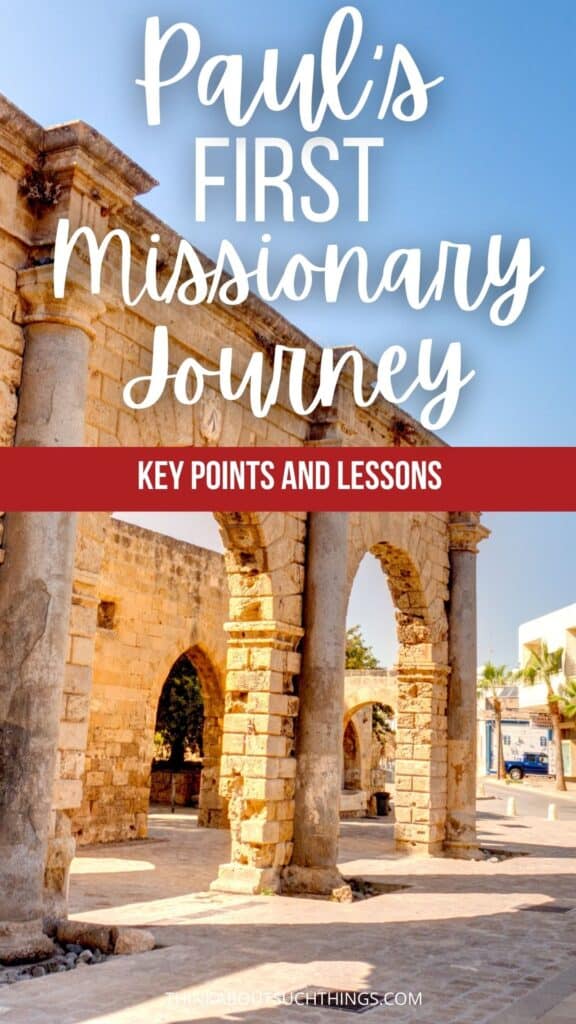
Table of Contents
What Happened On Paul’s First Missionary Journey?
Paul’s first missionary journey started during a prayer meeting in Antioch, Syria. We see in Acts 13:1-2 that a group of at least five prophets and teachers were gathered in prayer when the Holy Spirit told them to set Paul and Barnabas apart for the work that God called them for. The group fasted and prayed before sending them off.
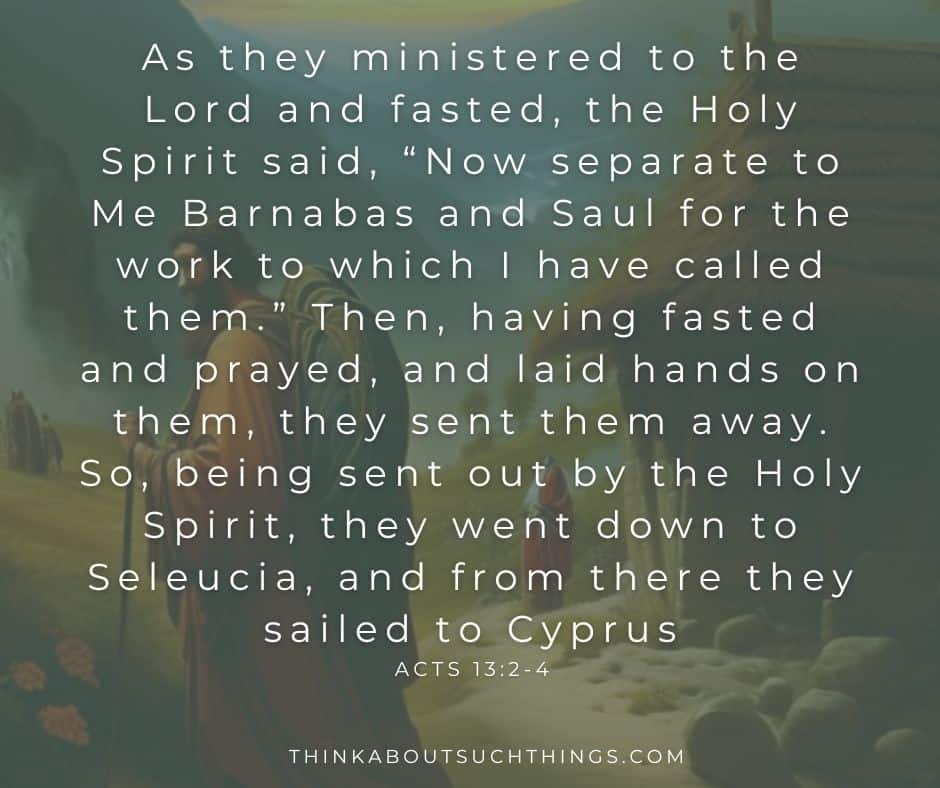
Before we get started, I do want to give a big thank you to Free Bible Image s for letting me use their images of Paul’s journey.
Cyprus – Salamis and Paphos
John Mark accompanied Paul and Barnabas in the beginning. They set off for Cyprus, an island off the coast of Turkey, and when they got to the port of Salamis, they preached the gospel in the Jewish synagogues.
It’s important to note that, at this time, many still considered the gospel to be exclusively for the Jews, which is why they focused on preaching in the synagogues.
The Bible doesn’t tell us how the Jews in Salamis received the gospel. All we know is that the three then went on across the island of Cyprus and got to the city of Paphos. This is where they were confronted by a sorcerer named Bar-Jesus, who was also a Jewish false prophet.
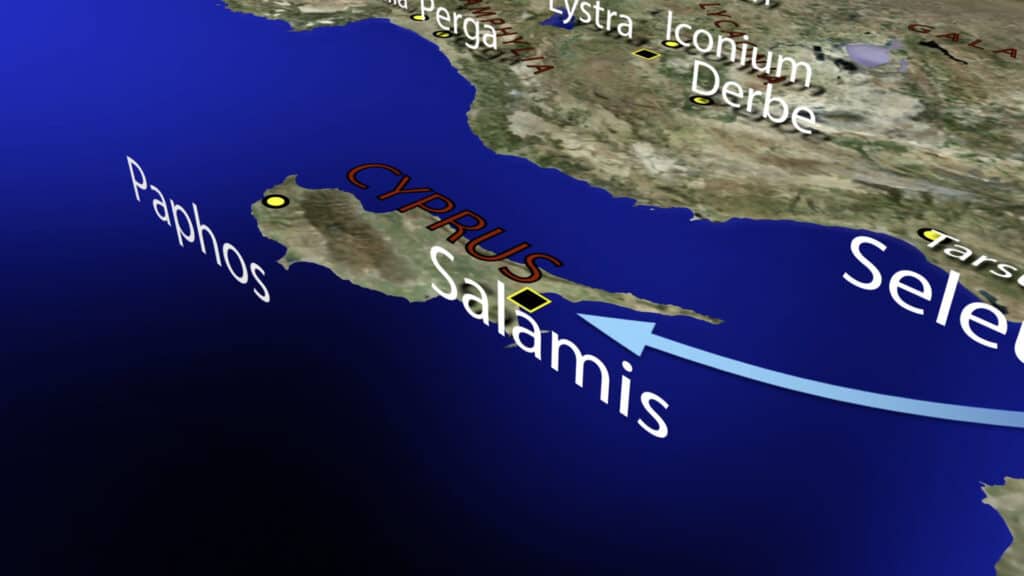
Bar-Jesus tried to keep the missionary team from seeing the Roman Proconsul, Sergius Paulus , who had requested to see them to hear the gospel.
However, Paul did not let the man stop them but instead identified the demons involved, after which Bar-Jesus was struck with temporary blindness.
Interestingly, this had the exact opposite result that Bar-Jesus had hoped – the proconsul believed and accepted the gospel partly because he saw what happened to the sorcerer at a mere word from Paul.
God can take something that is meant as a hindrance and turn it around for His glory.
The trio’s next stop was Perga, which was in Pamphylia, or Turkey as we know it today. Here a few interesting things happened that had significant repercussions.
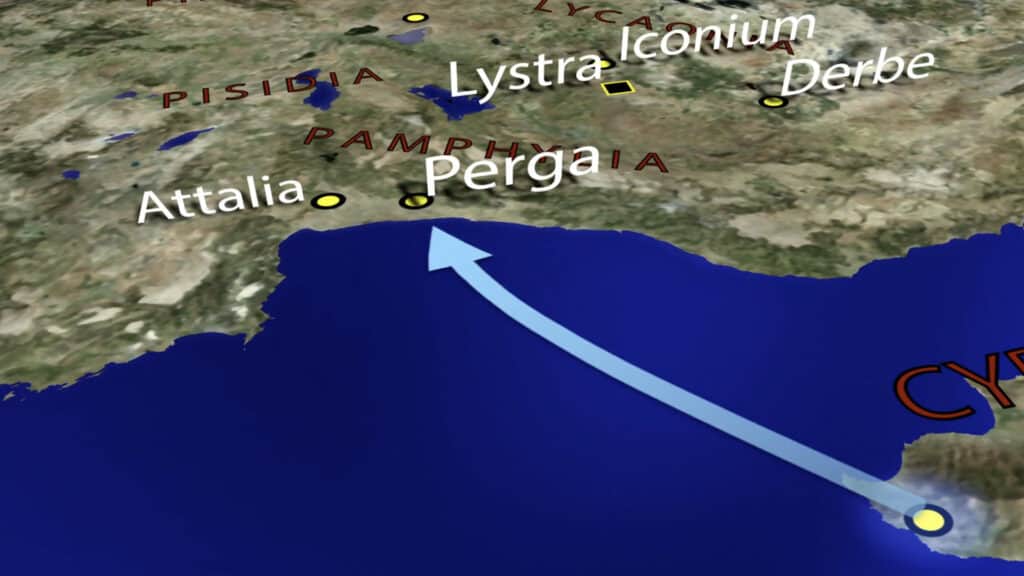
The first notable thing the Bible tells us here is that John Mark left the group and returned to Jerusalem. This is not explained in detail, but within the context of other passages, it seems that he and Paul had a falling out.
Experts believe it’s either to do with Mark being unable to keep up with Paul’s aggressive ministry style or that Mark wanted to report to the church in Jerusalem (the “head office” at the time) that Paul was preaching the gospel to Gentiles.
Whatever the reason, there are a few crucial things that happened because of this:
- Paul and Barnabas split up during later missionary trips because Barnabas wanted to take Mark along, while Paul didn’t. This effectively doubled the missionary efforts and caused the gospel to spread much faster.
- Mark spent a lot of time with Simon Peter in Jerusalem, who disciplined him further, and in the end, Mark wrote one of the gospels, which possibly would not have happened if he had stuck it out with Paul.
- Mark became indispensable to Paul in his later life, supporting him in ministry. Aristarchus my fellow prisoner greets you, with Mark the cousin of Barnabas (about whom you received instructions: if he comes to you, welcome him), – Colossians 4:10 Only Luke is with me. Get Mark and bring him with you, for he is useful to me for ministry. – 2 Timothy 4:11
The second important thing is that Paul preached to the Jews, who were so impressed that they invited him to return to preach more, but they got jealous when they saw how many people showed up to hear Paul’s preaching and started insulting him.
This motivated Paul to focus on the Gentiles, instead, who received the gospel with gladness (13:48).
The Jews got even more upset and drove Paul and Barnabas from the region, after which they went to Iconium.
As was their habit, Paul and Barnabas preached at the synagogue in Iconium, but not to the Jews only. The Greeks were also present. God did many signs and wonders by the apostles’ hands, and many Jews and Greeks believed the gospel because of these signs.
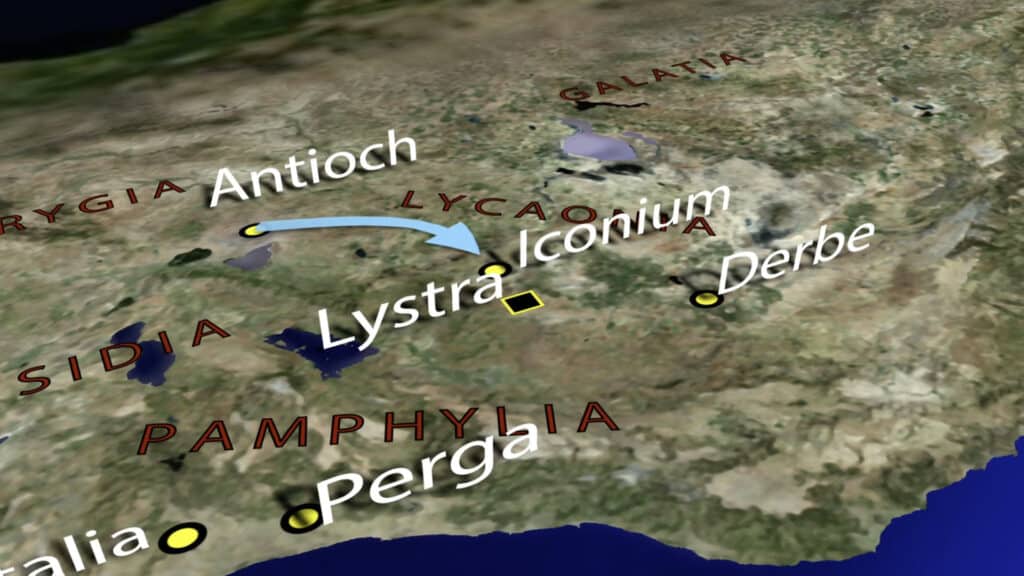
However, some non-believing Jews divided the city against Paul and Barnabas and started plotting to have them stoned (Acts 14:5).
So, after preaching in Iconium for a long time, they were forced to flee the region and go to Lystra and the surrounding areas to preach there.
As Paul was preaching in Lystra, a disabled man sat and listened to him. Paul gave the command for the man to be healed, and he jumped up and walked.
This made the area’s people believe that Paul and Barnabas were the Greek gods Zeus and Hermes. They tried to worship them, which they resisted and told them not to do.
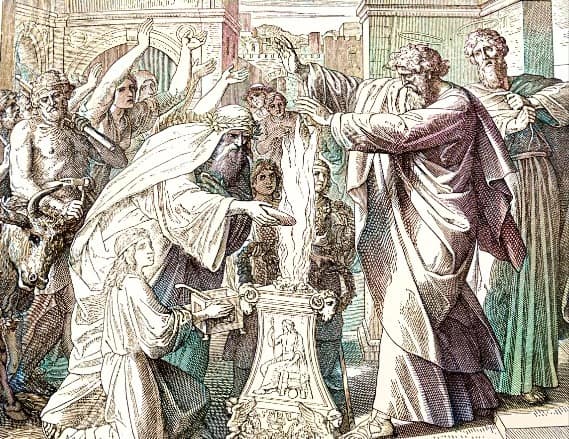
However, as promising as the outreach had been, some of the Jews from Iconium and Antioch had followed Paul and Barnabas to Lystra and turned the crowds against them.
They stoned Paul in an attempt to kill him and dragged him out of town, believing he was dead. However, Paul rose and accompanied the disciples back into the city.
Derbe And The Home Stretch
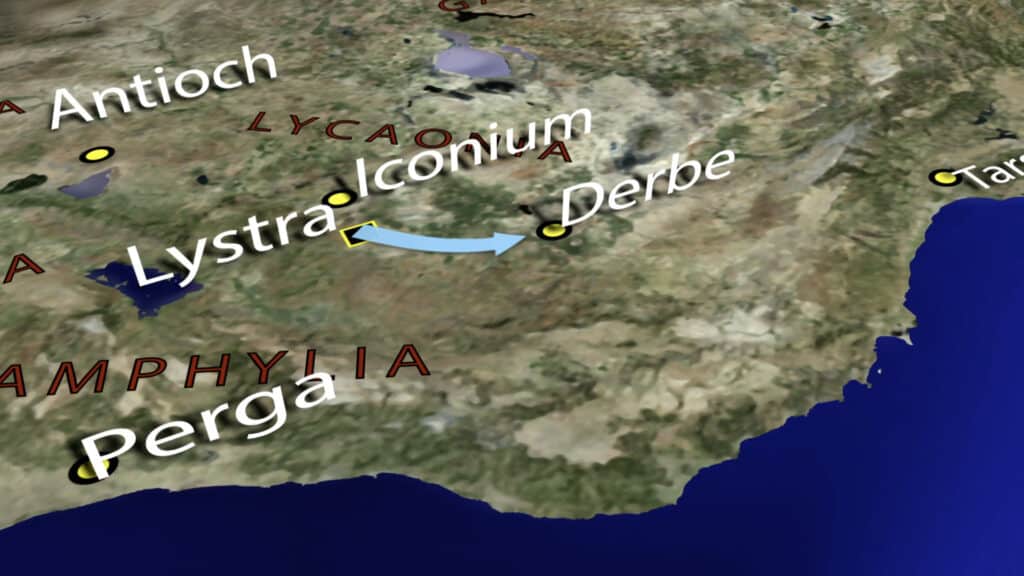
The next day, Paul and Barnabas went from Lystra to Derbe, where they preached the gospel and made many new disciples. Then they started their journey back to Antioch in Syria, the church that had sent them out.
On their way back, they passed through the cities they had preached in – Lystra, Iconium, and Perga – to encourage the disciples and appoint elders for the churches there.
Check Out Paul’s Other Missionary Journeys:

Maps of Paul’s First Missionary Journey
As a visual person, I find looking at images and maps very helpful, especially when looking at certain Biblical journeys and events. The overall map of Paul’s first journey is below.
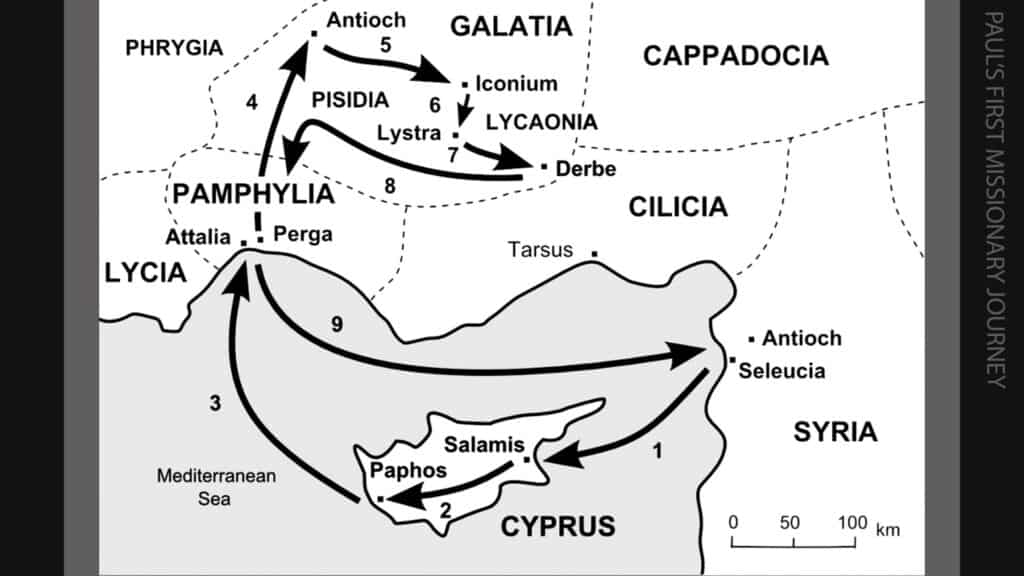
This map below is a little more realistic. It doesn’t show Paul’s journey path, but it shows the cities and the terrain better.
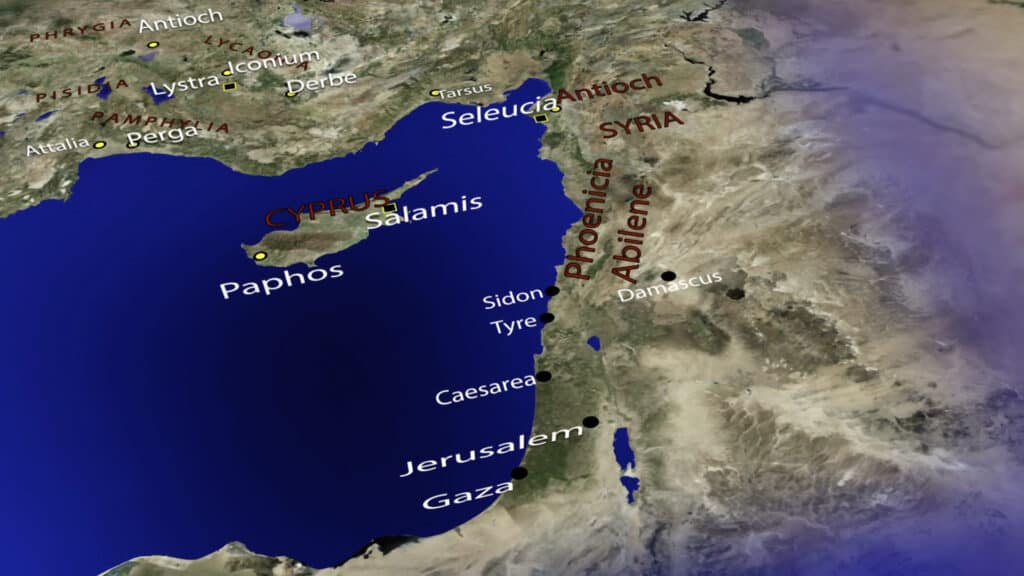
Lessons For Christians On Paul’s 1st Journey
We can learn many things from Paul’s missionary journey, and God tends to reveal more each time you study it. But here are a few notable lessons for modern believers from Paul’s first missionary journey:
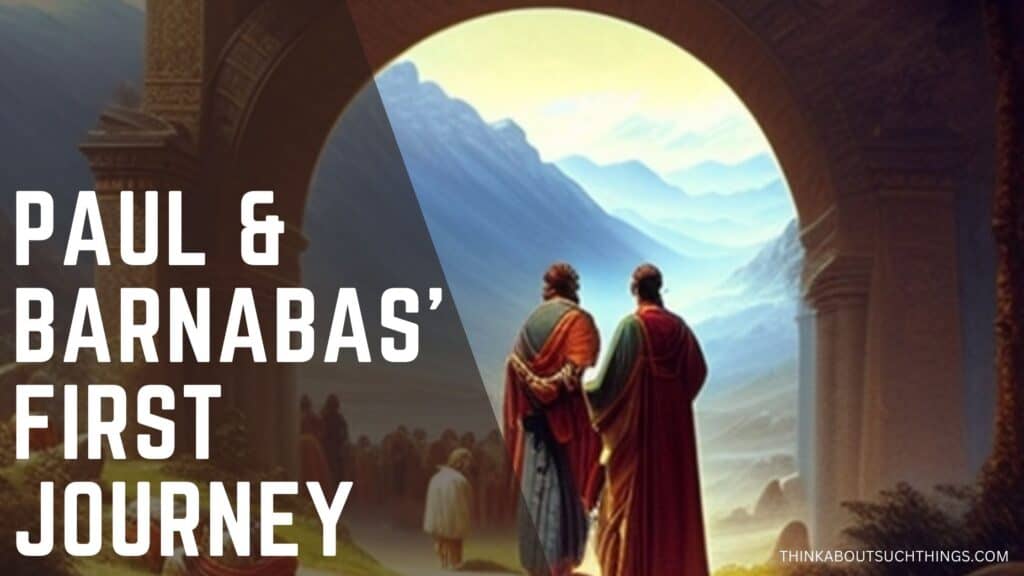
- We know that all believers are called to spread the gospel, but our efforts should always go hand in hand with the guidance of the Holy Spirit and be confirmed during fasting and prayer. Yes, God can turn our mistakes into victories, but with significant steps like a 1,400-mile missionary journey, it’s good to be sure before we start, just like Paul’s journey started with prayer.
- The enemy will try to stop us when we live a life dedicated to sharing the gospel and building God’s Kingdom. But God can turn that opposition into a miracle that will prove His power and glory to all if we stand firm and are willing to risk everything for our faith, just like He did when Bar-Jesus opposed the team.
- Like Paul and John Mark, we don’t always get along with our fellow believers, and sometimes our missions take us in opposite directions. However, we are still called to love and support one another as members of one body. Besides, we never know when God will bring us back together, and we could find strength in unlikely alliances.
- God will not hesitate to perform signs and wonders to show His power if it is to expand His kingdom. We can see in Mark 16:20 that the disciples went out and preached the gospel everywhere and that God confirmed the message by accompanying signs. As long as we seek the kingdom and aim to share the gospel, God will work with us to accomplish that goal.
Key People On Paul’s 1st Journey
Here is a quick look at key players during the 1st missionary journey.
Paul, also known as Saul of Tarsus, was an important figure in the Bible who played an instrumental role in spreading Christianity. Born in the city of Tarsus, Paul was a devout Jew and Pharisee who was initially hostile towards the teachings of Jesus. However, he underwent a transformation on the road to Damascus where he claimed to have had a divine encounter with Christ. From there, Paul dedicated his life to preaching the gospel and writing numerous letters, or epistles, which are now part of the New Testament.
Barnabas was a Levite from Cyprus and a follower of Jesus Christ. In the Bible, he was first mentioned in the book of Acts, where he sold a field he owned and gave the proceeds to the apostles to support the early church. Barnabas was known for his generosity and kindness towards others, which earned him the nickname, “Son of Encouragement.”
John Mark was a companion of the Apostle Paul and is commonly believed to be the author of the Gospel of Mark. In the book of Acts, John Mark is also mentioned as the cousin of Barnabas and as a helper in various mission trips. However, there is also a record of John Mark abandoning Paul and Barnabas in one of their missions, causing a rift between the two men, which later was reconciled.
Bar-Jesus, was a Jewish sorcerer and false prophet who opposed the teachings of Paul and Barnabas. He tried to prevent the Roman proconsul, Sergius Paulus, from accepting Christianity, but Paul, filled with the Holy Spirit, called him out for his deceit and struck him blind.
Sergius Paulus
Sergius Paulus was the Roman proconsul of Cyprus. He is significant to biblical history as he became a follower of Christ after witnessing the power of God through the evangelist Paul. Sergius Paulus was a man of authority and intellect, yet he was humbled by the miraculous events that occurred before him.
FAQ About Paul’s First Missionary Journey
Here are some common FAQ asked about Paul’s 1st trip.
You can read about the Apostle Paul’s first journey in Acts 13:1-14:28.
The first journey took place between 47-49 AD.
Barnabas and John Mark accompanied the apostle Paul.
Paul and his companions traveled through Cyprus and Turkey.
Paul traveled around 1,400 miles! Which is amazing since his only mode of transportation was by foot, boat, and maybe some kind of animal. But it’s important to note that no horses or other animals are mentioned in scripture.
Paul’s first missionary journey was incredibly eventful. They attempted to kill him and almost succeeded once. Not everyone received the gospel with gladness. And yet, they pushed on and accomplished some great things, converting many people to Christianity and establishing new churches as they went. We should take that as an encouragement to share the gospel with everyone we meet.
And as always, if you would like to leave me a comment. I would love to hear from my readers and what God is doing in your life.
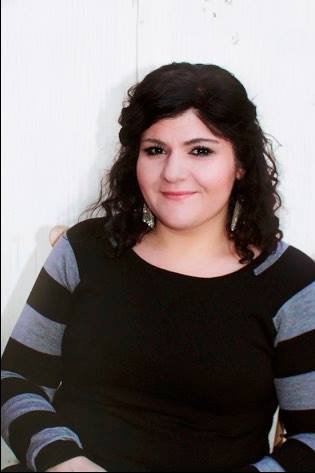
Melissa is a passionate minister, speaker and an ongoing learner of the Bible. She has been involved in church and vocational ministry for over 18 years. And is the founder of Think About Such Things. She has the heart to equip the saints by helping them get into the Word of God and fall more in love with Jesus. She also enjoys family, cooking, and reading.
She has spoken in churches in California, Oregon, Texas, and Mexico and has been featured in Guidepost Magazine and All Recipes Magazine. Read More…
I accept the Privacy Policy
Friday 14th of April 2023
I love reading your book thank you .. I'm born again Christian and was married to my husband 3 years ago and 3 months ago he left me .I'm hoping he will come back please keep me in your prayers. Sarah

Paul’s Missionary Journeys: The Beginner’s Guide
by Ryan Nelson | Jul 6, 2020 | Bible topics
Paul’s missionary journeys helped spread the gospel throughout much of the ancient world. Over the course of his ministry, the Apostle Paul traveled more than 10,000 miles and established at least 14 churches.
The Book of Acts records three separate missionary journeys that took Paul through Greece, Turkey, Syria, and numerous regions you won’t find on modern-day maps. Some scholars argue that Paul also took a fourth missionary journey, since parts of the New Testament appear to reference travels that may have taken place after the events in Acts.
Paul’s travels played a crucial role in the formation and development of the early Christian church. Many of the communities he encountered on these missionary journeys were the same ones he wrote to in his pastoral epistles.
In this guide, we’re going to follow Paul’s footsteps as he travelled across the ancient world, looking at the places he went and the major events that took place along the way. At times it can be challenging to distinguish between ancient cities, provinces, and regions (and there are sometimes multiple names that refer to the same area), so as we go, we’ll make some of those distinctions more clear.
Paul’s first missionary journey (Acts 13–14)
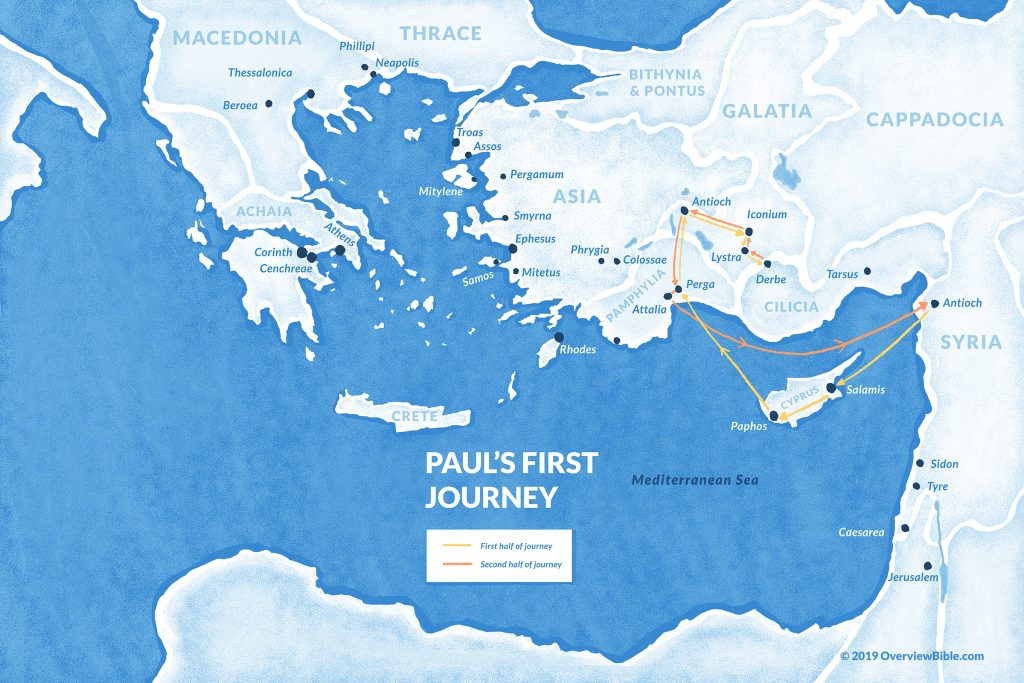
Paul’s first missionary journey began in Antioch. You may notice that maps of the ancient world often have two cities labelled Antioch. They’re both named after Antiochus, father of Seleucid I. The Antioch in Acts 13 was the third largest city in ancient Rome and capital of the province of Syria. Today, it’s part of southern Turkey. The other Antioch was part of Pisidia, an ancient region which is also now part of Turkey. Your Bible likely refers to it as Pisidian Antioch or Antioch of Pisidia.
In Antioch (the big city in Syria), the Holy Spirit singled out Paul and Barnabas from the believers worshiping there, and sent them on their first missionary journey.
Paul’s first journey took him by boat to the Roman province of Cyprus. Today, Cyprus is a country known as the Republic of Cyprus. It’s a mediterranean island south of Syria. Paul and Barnabas arrived in the port city of Salamis, where John Mark (who was possibly Barnabas’ cousin), helped them share the gospel in Jewish synagogues.
From Salamis, the group moved across the island to Paphos, where they were met by a Jewish sorcerer named Bar-Jesus (also known as Elymas the sorcerer). This sorcerer worked for the governor—Sergius Paulus—who sent for Paul and his companions because he wanted to hear the word of God. Elymas opposed them and tried to turn Sergius from the faith, and so Paul, filled with the Holy Spirit, called him a “child of the devil” and struck him blind. Sergius saw what happened, and believed.
Ironically, Elymas meant to steer Sergius away from Christ, but he became the very vehicle God used to draw Sergius toward him.
From Paphos, Paul and company set sail for the Roman province of Pamphylia, located in modern day Turkey. They arrived in the city of Perga, where John Mark left them and returned to Jerusalem (which, interestingly, was in the opposite direction from where they just came). We don’t know why John Mark decided to leave, but this would later create a rift between Paul and Barnabas.
Together, Paul and Barnabas travelled to Pisidian Antioch, where local synagogue leaders invited them to speak. Initially, the Jewish people were receptive to the gospel, but a week later, the entire city gathered to hear Paul and Barnabas, and the Jewish leaders became jealous. They resisted the message of the gospel, and so Paul and Barnabas made an important pivot: they began preaching to the Gentiles.
Many of the Gentiles believed the gospel, and Luke (the traditional author of Acts) tells us that:
“The word of the Lord spread through the whole region. But the Jewish leaders incited the God-fearing women of high standing and the leading men of the city. They stirred up persecution against Paul and Barnabas, and expelled them from their region.” —Acts 13:49–50
Driven out of Pamphylia, Paul and Barnabas travelled to Iconium, an eastern city in the region of Phrygia. Iconium still exists today as the Turkish city of Konya.
Once again, Paul and Barnabas spoke in the synagogue, where Jews and Greeks alike accepted the gospel. But the Jews who didn’t accept it stirred up trouble, even as Paul and Barnabas began performing signs and wonders (Acts 14:3). As support for Paul and Barnabas grew, so did the opposition they faced, and eventually, they became aware of a plot to abuse and stone them. So they left.
Fleeing the threat in Iconium, Paul and Barnabas left Phrygia altogether and travelled to Lystra, a city in the province of Lycaonia. Here, Paul healed a man who was lame.The locals who witnessed this miracle thought Paul and Barnabas were gods in human form, calling Barnabas Zeus and Paul Hermes. The priest from the temple of Zeus brought bulls and wreaths to offer sacrifices to them.
Paul and Barnabas attempted to redirect their praise to God, but struggled to keep the crowds from offering sacrifices to them.
Jews came from Antioch and Iconium and continued what they’d started. They riled up the crowds and convinced them to stone Paul. Believing he was dead, they dragged him outside the city. When the disciples gathered around him, Paul got up and went back inside the city.
Then Paul and Barnabas went to Derbe, another city in Lycaonia. There, they “won a large number of disciples” (Acts 14:21).
The return to Antioch
After a time in Derbes, Paul and Barnabas went back the way they came, working their way through Lystra, Iconium, Pisidian Antioch, and Perga. In each city, they encouraged the believers there and strengthened their faith, as they would continue doing on their future missionary journeys. They did, however, stop in a new Pamphylian city on the way: Attalia. Acts only mentions it in passing, but presumably, they established a community of believers there as well.
From there, they skipped a return voyage to the island of Cyprus and went straight back to Antioch (the big one), where they told the church what happened on their journey.
Paul’s second missionary journey (Acts 16:23–20:38)
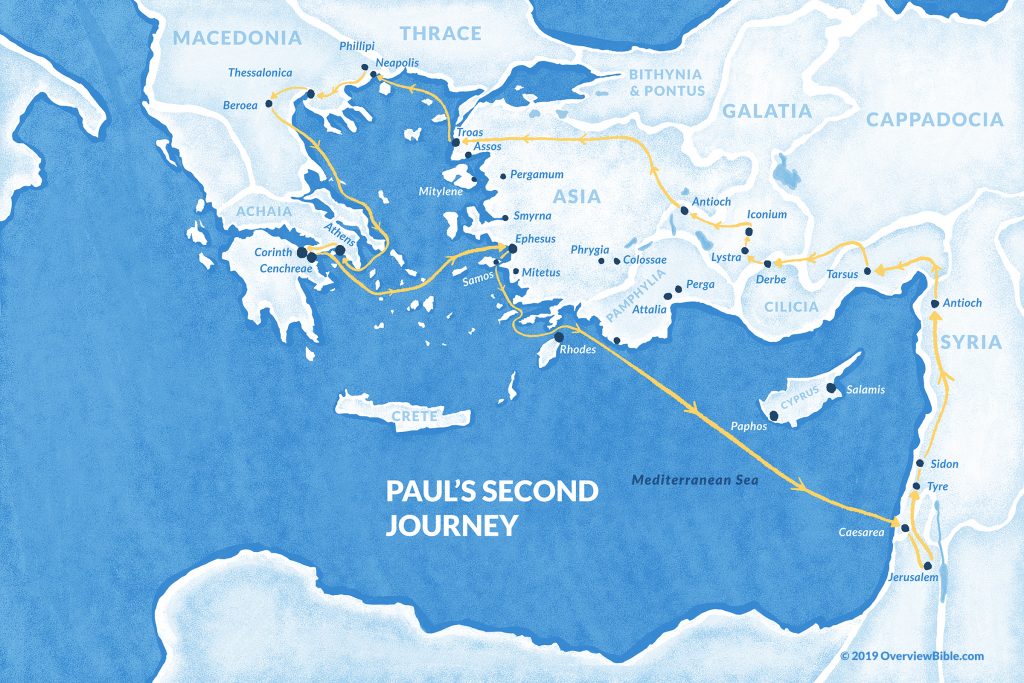
Paul’s second missionary journey established many of the churches he would later write to in his pastoral epistles. Interestingly, this may have happened in part because of a “sharp disagreement” he had with Barnabas. Paul’s original plan was to essentially have a rerun of their first trip, strengthening the communities they’d formed in each city and telling them what the Council of Jerusalem had ruled in regards to Gentile believers.
But Barnabas wanted to take John Mark—who had left them shortly into their previous journey. Paul was so opposed to the idea that they parted ways, initiating two separate missionary journeys. Barnabas took John Mark and went with the original plan, making their way back to the island of Cyprus. Paul took a man named Silas and travelled through the provinces of Syria and Cilicia.
The first cities that Acts mentions by name on Paul’s second journey are Derbe and Lystra. At this time, Paul and Silas picked up a new companion: Timothy.
The locals spoke highly of Timothy, and Paul wanted to bring him along even though he was half Greek, which meant local Jews would have a harder time accepting their message. Out of concern for these local Jews, Paul circumcised Timothy—even though, ironically, one of the things they were coming to tell Christians was that Gentiles didn’t have to be circumcised. (See Acts 16:3–4.)
Acts doesn’t specify where in Phrygia Paul and his companions stopped, but since he’d established a church in Iconium on the first trip, that community would’ve been on his mind (even though last time he was there, people had plotted to stone him). Interestingly, Acts notes that Paul and his companions journeyed here after they were “kept by the Holy Spirit from preaching the word in the province of Asia” (Acts 16:6).
Just north of Phrygia was the province of Galatia. Acts makes no mention of what happened here, but this is the province Paul wrote to in his letter to the Galatians . Interestingly, part of the purpose of Paul’s second trip was to share the news from the Council of Jerusalem regarding the Law of Moses and whether or not Gentiles (or Christians in general) should be expected to follow it. The council decided the Torah didn’t apply to Gentile believers (though they did hang on to a few rules). But by the time Paul wrote the Book of Galatians, Christians there were feeling pressure to obey the law (particularly in regards to circumcision) in order to be saved.
From Galatia, Paul’s group traveled west, until they reached the border of Mysia—a western region in the province of Asia, which is now part of Turkey. They intended to head north to the region of Bithynia, “but the spirit of Jesus would not allow them to” (Acts 16:7). So they passed by Mysia and headed to the city of Troas. Here, Paul had a vision of a man in Macedonia, begging him to “Come over to Macedonia and help us.” Paul took this vision as a sign that God was calling them to Macedonia, which was across the Aegean Sea.
From Troas, Paul and his companions sailed across the Aegean Sea, making a pitstop on the island of Samothrace before landing in Neapolis and then traveling to Philippi. In Philippi, they spoke with women outside the city gate. One of them was a wealthy cloth dealer named Lydia. After her household was baptised, she persuaded Paul’s group to stay with her for a while.
Later, Paul, Silas, and the others were confronted by a spirit-possessed slave woman who could predict the future. She followed them for many days, shouting, “These men are servants of the Most High God, who are telling you the way to be saved” (Acts 16:17). Paul became so annoyed that he cast out the spirit. Her owners were furious, because they had been profiting off of her fortune telling. So they turned the local magistrates against them, claiming Paul and Silas were stirring up trouble and trying to get Roman citizens to believe and do illegal things.
The authorities had Paul and Silas severely flogged and thrown in prison. Late at night, while they were worshiping, an earthquake shook the foundations of the prison, opened the doors, and freed the prisoners from their chains. When the jailer awoke and saw the doors open, he prepared to kill himself. But Paul stopped him and assured him everyone was still in the prison.
After listening to Paul and Silas share the gospel, the jailer believed in Jesus and had his whole household baptized.
The next morning, the magistrates ordered Paul and Silas released. Paul revealed that they were Roman citizens, who had just been beaten and imprisoned without trial, and the authorities became afraid. Paul and Silas returned to Lydia’s house, and then left the city of Troas.
After passing through the Macedonian cities of Amphipolis and Apollonia, they arrived in Thessalonica. Since Thessalonica had a synagogue, Paul turned to his usual method—preaching the gospel on the Sabbath. Over the course of three weeks, he achieved the usual result—many Jews and Greeks alike embraced the gospel . . . and those who didn’t were outraged by it.
At night, the Thessalonian believers sent Paul and his companions away to the nearby city of Berea.
The Bereans listened eagerly to the gospel and carefully examined the Scriptures to see if they supported Paul’s claims. Many Jews and Greeks became believers, but some agitators from Thessalonica heard Paul was in Berea, and they stirred up the crowds. Silas and Timothy stayed in Berea, while Paul was escorted out of Macedonia to Athens.
In the first century, Athens was in the region of Achaia, just south of Macedonia. Today, it’s the capital of Greece, and the largest city in the country.
Paul was essentially waiting around for Silas, Timothy, and the others to rejoin him. But while he waited, he noticed that Athens was full of idols. He debated with philosophers in both the synagogue and marketplace. Some Athenians were open to his ideas, and they were eager to discuss them. One idol in particular caught his eye—it had an inscription that read: “to an unknown god.” He seized on this as an opportunity to tell them about the “unknown God” who died and rose so that all might have eternal life.
Paul’s message in Athens incorporated observations about what he saw around him as well as quotes from famous Greek philosophers to point back to the gospel. After establishing a group of believers in Athens, Paul headed west to the city of Corinth.
In Corinth, Paul stayed and worked with a couple of Jewish tentmakers named Priscilla and Aquila. Every Sabbath, he preached to Jews and Greeks in the synagogue. Silas and Timothy rejoined Paul here, and Paul began focusing his energy on testifying about Jesus to the Jews.
When the Jews opposed his message, Paul devoted himself to reaching Gentiles, and he left the synagogue. As more Greeks embraced the gospel, the Corinthian Jews brought Paul before the governor, who basically told them to take a hike and refused to help.
Paul stayed in Corinth for a year and a half, and he left with Priscilla and Aquila.
The return journey
Before setting off for Syria, Paul stopped for a vow-fulfilling haircut in the port city of Cenchreae, which was just a hop, skip, and a jump from Corinth. With his companions, he sailed across the Aegean Sea to Ephesus, where he dropped of Priscilla and Aquila, and promised to come back if he could. After a short stay in Ephesus, Paul set sail for Caesarea, which was across the Mediterranean and far to the southeast. From there, he made the trek south to Jerusalem.
Paul’s second missionary journey ended in Jerusalem.
Paul’s third missionary journey (Acts 18:23–20:38)
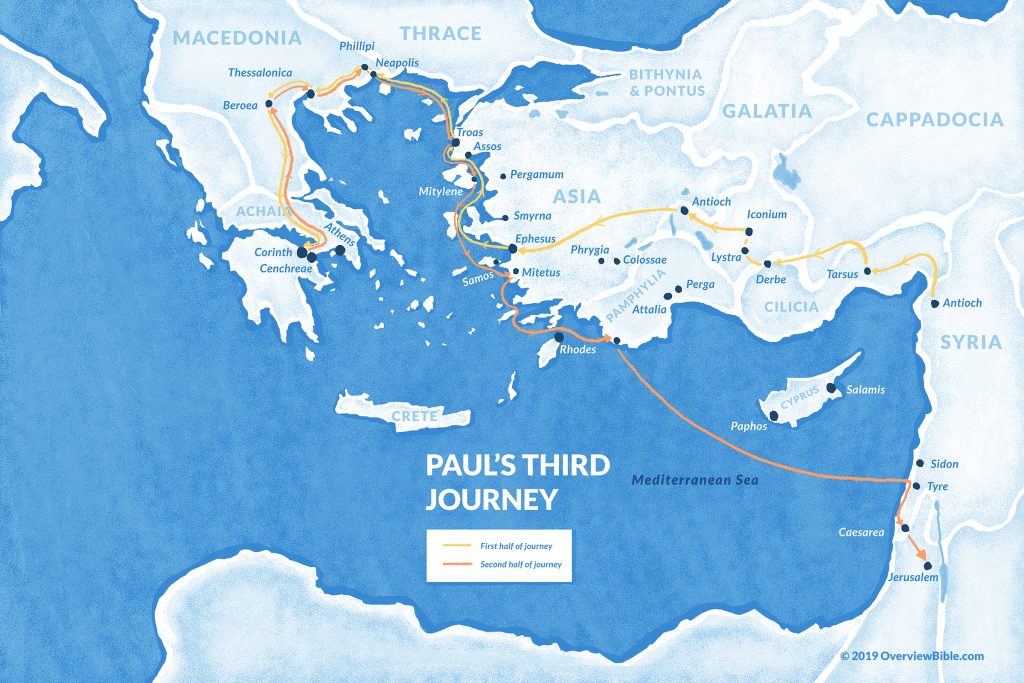
When you read Acts, there’s no transition from Paul’s second missionary journey to his third. His arrival in Jerusalem almost immediately began his next trip. But while his second journey ends in Jerusalem, the beginning of his third journey is actually in Antioch, which is about 300 miles north.
Phrygia and Galatia
From Antioch, Paul once again worked his way west, passing “from place to place throughout the region of Galatia and Phrygia, strengthening all the disciples” (Acts 18:23). This included Derbe, Lystra, and Iconium.
Paul traveled west to Ephesus, the capital of the province of Asia, where he’d left Priscilla and Aquila on his previous journey. Since he’d last visited, a man named Apollos had been preaching part of the gospel, but he didn’t know about the Holy Spirit. So when Paul arrived, he taught the Ephesians about the difference between water baptism and the baptism of the Spirit.
For three months, Paul preached in the synagogues. When people started criticizing Christianity, he left and began holding discussions in a lecture hall.
This went on for two years, and all the while, God used Paul to perform miracles. Even things Paul had touched—handkerchiefs and aprons—healed the sick and drove out evil spirits.
Some Jews thought invoking Paul’s name would let them drive out demons. Seven sons of a chief priest named Sceva said to an evil spirit, “In the name of the Jesus whom Paul preaches, I command you to come out” (Acts 19:13). The spirit replied that it knew Jesus and Paul, but not them, and then it pulverized all seven of them.
As word spread about what happened, people began to revere the name of Jesus. Local sorcerors came to repent, and they burnt scrolls that would have been worth more than 130 years’ worth of wages (Acts 19:19).
Around this time, a local silversmith named Demetrius realized that the future of his business (making idols) was jeopardized by the gospel. The demand for idols was going down all across the province of Asia, but especially in Ephesus, where he lived. So Demetrius gathered all the craftsmen and workers whose businesses were impacted, and stirred the entire city into an uproar. They seized two of Paul’s companions and brought them into a theater.
Paul wanted to address the crowd, but the disciples didn’t let him. Instead, a city clerk told everyone that unless they were going to bring formal charges against the men in a legal assembly, they were in danger of being charged with rioting.
Macedonia and Greece
After things settled down in Ephesus, Paul headed across the Aegean Sea to Macedonia. He traveled throughout the region, encouraging believers, and eventually arrived in Greece, where he stayed for three months. He intended to sail back to Syria (where his journey started), but some people plotted against him, so he took another lap through Macedonia instead.
Along the way, disciples joined Paul from many of the communities he’d ministered to. He had companions from Berea, Thessalonica, Derbe, and the province of Asia. These followers went ahead of Paul to Troas, in Asia. Paul stayed briefly in Philippi, then joined them.
Paul stayed in Troas for seven days. The night before he left, he stayed up late talking in a room upstairs. A young man sat in a window, drifted off to sleep, and fell to his death. Paul threw his arms around the man and declared that he was alive, and he was. Then Paul went back upstairs and continued talking until daylight.
Paul walked from Troas to Assos, which was just to the south, and then sailed for the nearby city of Mitylene. Eager to reach Jerusalem before Pentecost, Paul sailed past Ephesus and stopped in Miletus. There, he met with the leaders of the Ephesian church and essentially told them that he had taught them everything they needed to know, that he would not see them again, and that they needed to be on guard against false teachers. This is when Paul also famously quoted Jesus, sharing words that aren’t recorded in any of the gospels: “It is more blessed to give than to receive” (Acts 20:35).
And then he set sail.
Paul and his companions stopped briefly in Kos, Rhodes, and Patara before heading across the Mediterranean Sea to Phoenicia (the coastal region south of ancient Syria, which is now part of Syria). They arrived in Tyre, where “through the Spirit” (Acts 21:4), the local disciples urged Paul not to go to Jerusalem. He ignored them.
From Tyre, the voyage continued to the port city of Ptolemais, and then Caesarea, where the group stayed with Philip the evangelist (not to be confused with Philip the apostle ). Here, a prophet warned Paul that he would be bound by the Jews in Jerusalem and handed over to the Gentiles.
Still, he pressed on to Jerusalem, and by the end of Acts, the Jewish leaders had handed him over to Roman rulers.
Paul’s fourth missionary journey
Acts explicitly records three distinct missionary journeys. But some scholars and even ancient Christian writers have claimed that there was also a fourth missionary journey which was only hinted at in the Bible.
The argument for a fourth journey is primarily based on clues from Paul’s letters. He occasionally refers to events and visits that may not be accounted for in Acts or the epistles.
For example, Paul suggested he would travel to Spain (Romans 15:24), but he provides no record of this journey in his letters. However, early church fathers claimed Paul did, in fact, travel to Spain.
In his letter to the Corinthians, first-century church father Clement of Rome said Paul “had gone to the extremity of the west,” which at the time presumably meant Spain. Fourth-century church father John of Chrysostom said, “For after he had been in Rome, he returned to Spain, but whether he came thence again into these parts, we know not.” And Cyril of Jerusalem (also from the fourth century) wrote that Paul “carried the earnestness of his preaching as far as Spain.”
In 2 Timothy 4, Paul makes an ambiguous reference to “my first defense” and claims he was “delivered from the lion’s mouth” (2 Timothy 4:16-17). Some have interpreted this as a reference to his first defense before Emperor Nero, which he was heading for at the end of Acts.
Paul’s letters make other references to events not recorded in Acts, but since there is so much overlap in the locations mentioned, and Paul spent multiple years in some of these places on his three recorded journeys, it’s difficult to say whether or not this fourth journey ever actually happened.
Take a closer look at Paul’s footsteps
Paul’s missionary journeys are a key part of the New Testament. Paul’s epistles were originally written to the communities he formed on these journeys, and they show us exactly how Christianity spread to the Gentiles so rapidly.
Here at OverviewBible, we’ve charted each of Paul’s missionary journeys into beautiful, full-color posters you can display in your classroom or church office. Each comes in multiple sizes on fine art paper with a matte finish.

Get an overview of the entire Bible
The Bible is huge. Together, its 66 books are three times longer than Moby Dick . It’s so big that even if you’ve been reading it your whole life, you can still miss the point. Jeffrey Kranz, founder of OverviewBible, wrote The Beginner’s Guide to the Bible to help Christians and non-Christians alike get a better grasp of this important text.
This non-preachy, jargon-free guide will walk you through the Bible’s major themes and characters and help you see how each book fits into the larger story of Scripture.
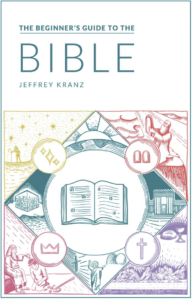
Explore the Bible with us!
We create research-based articles and handy infographics to help people understand the Bible.
Join our email list, and we’ll send you some of our best free resources—plus we’ll tell you whenever we make something new.
You have Successfully Subscribed!

- Bible Books
- Bible characters
- Bible facts
- Bible materials
- Bible topics
Recent Posts
- Interesting Facts about the Bible
- Logos Bible Software 10 review: Do you REALLY need it?
- Who Was Herod? Wait… There Were How Many Herods?!
- 16 Facts About King David
- Moses: The Old Testament’s Greatest Prophet
Privacy Overview
Paul’s First Missionary Journey ( Acts 13:4–14:26 )
C. a.d. 46–47.
Barnabas and Paul first visited Barnabas’s home region of Cyprus before sailing to the southern region of Asia Minor. When they reached Perga in Pamphylia, John Mark left the group and returned to Jerusalem. Making their way to Antioch (in Pisidia), Iconium, Lystra, and Derbe, Paul and Barnabas were driven out of each city by jealous Jewish religious leaders. Later they returned by the same route, strengthening the new churches as they went. From Attalia they set sail for their home in Antioch of Syria.


Bible Pearls
Did you know that....
The Holy Spirit is one of the most misinterpreted concepts of the Bible. Different denominations of Christianity have different definitions for it.
But, who or what is the Holy Spirit? And is it male or female in the Bible? Is it the third God of the Trinity? Today you can finally learn the truth about this apparently confusing issue.
If you would like to know who or what the Holy Spirit truly is in the Bible and solve this problem, check out our article on this topic in our Bible Articles section, you will find it very interesting.

SIGN UP FOR OUR NEWSLETTER
Related articles you might like.

Paul's First Missionary Journey Map

Paul's Second Missionary Journey Map

Paul's Third Missionary Journey Map

Paul's Journey to Rome Map

Timeline of Paul's Letters and Missionary Journeys Chart
If You Found This Helpful, Please Share. Thanks!

ConformingToJesus Ministry - Copyright © 2014-2023. All Rights Reserved
Map of Paul's first mission journey
From about 46 AD to 48 AD (more than 1900 years ago), Paul the evangelist undertook his first mission journey. He traveled from Syrian Antioch to Derbe, and back again. This journey is described in the Bible's book of Acts, chapters 13 and 14. Click on any of the map markers and more information about that place will pop up.
Source: Research by About-Jesus.org
Interactive Bible maps:
• Places where Jesus performed miracles
• Places that Jesus visited
• Paul's 1st mission journey
• Paul's 2nd mission journey
• Paul's 3rd mission journey
• Paul's journey to Rome
• Seven churches in Revelation
• Bible places map
• List of interactive maps
About Jesus
About Christianity
About the Bible
Interactive Bible maps
Other items
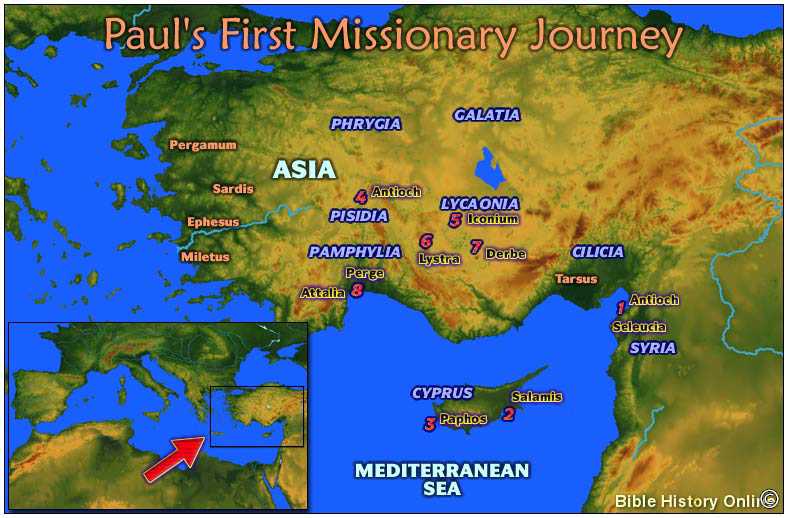
The Boundaries of the Roman Empire were: North : The British Channel, the Rhine, the Danube, and the Black Sea South : The deserts of Africa, the cataracts of the Nile, & the Arabian deserts East : The Euphrates West : The Atlantic
Romans 1:7 - To all that be in Rome , beloved of God, called [to be] saints: Grace to you and peace from God our Father, and the Lord Jesus Christ.
Paul in the Smith's Bible Dictionary
Paul (small, little). Nearly all the original materials for the life St. Paul are contained in the Acts of the Apostles and in the Pauline epistles. Paul was born in Tarsus, a city of Cilicia. (It is not improbable that he was born between A.D. 0 and A.D. 5.) Up to the time of his going forth as an avowed preacher of Christ to the Gentiles, the apostle was known by the name of Saul. This was the Jewish name which he received from his Jewish parents. But though a Hebrew of the Hebrews, he was born in a Gentile city. Of his parents we know nothing, except that his father was of the tribe of Benjamin, Phm 3:5 and a Pharisee, Ac 23:6 that Paul had acquired by some means the Roman franchise ("I was free born,") Ac 22:23 and that he was settled in Tarsus. At Tarsus he must have learned to use the Greek language with freedom and mastery in both speaking and writing. At Tarsus also he learned that trade of "tent-maker," Ac 18:3 at which he afterward occasionally wrought with his own hands. There was a goat's-hair cloth called cilicium manufactured in Cilicia, and largely used for tents, Saul's trade was probably that of making tents of this hair cloth. When St. Paul makes his defence before his countrymen at Jerusalem, Ac 22:1 ... he tells them that, though born in Tarsus he had been "brought up" in Jerusalem. He must therefore, have been yet a boy when was removed, in all probability for the sake of his education, to the holy city of his fathers. He learned, he says, at the feet of Gamaliel." He who was to resist so stoutly the usurpations of the law had for his teacher one of the most eminent of all the doctors of the law. Saul was yet "a young man," Ac 7:58 when the Church experienced that sudden expansion which was connected with the ordaining of the seven appointed to serve tables, and with the special power and inspiration of Stephen. Among those who disputed with Stephen were some "of them of Cilicia." We naturally think of Saul as having been one of these, when we find him afterward keeping the clothes of those suborned witnesses who, according to the law, De 17:7 were the first to cast stones at Stephen. "Saul," says the sacred writer significantly "was consenting unto his death." Full Article
Paul in the Bible Encyclopedia - ISBE 5. The First Great Mission Campaign: Acts 13 and 14, 47 and 48 AD: Paul had already preached to the Gentiles in Cilicia and Syria for some 10 years. The work was not new to him. He had had his specific call from Jerusalem long ago and had answered it. But now an entirely new situation arises. His work had been individual in Cilicia. Now the Spirit specifically directs the separation of Barnabas and Saul to this work (Acts 13:2). They were to go together, and they had the sympathy and prayers of a great church. The endorsement was probably not "ordination" in the technical sense, but a farewell service of blessing and good will as the missionaries went forth on the world-campaign (Acts 13:3). No such unanimous endorsement could have been obtained in Jerusalem to this great enterprise. It was momentous in its possibilities for Christianity. Hitherto work among the Gentiles had been sporadic and incidental. Now a determined effort was to be made to evangelize a large section of the Roman empire. There is no suggestion that the church at Antioch provided funds for this or for the two later Campaigns, as the church at Philippi came to do. How that was managed this time we do not know. Some individuals may have helped. Paul had his trade to fall back on, and often had resort to it later. The presence of John Mark "as their attendant" (Acts 13:5) was probably due to Barnabas, his cousin (Col 4:10). The visit to Cyprus, the home of Barnabas, was natural. There were already some Christians there (Acts 11:20), and it was near. They preach first in the synagogues of the Jews at Salamis (Acts 13:5). We are left to conjecture as to results there and through the whole island till Paphos is reached. There they meet a man of great prominence and intelligence, Sergius Paulus, the Roman proconsul, who had been under the spell of a sorcerer with a Jewish name--Elymas Bar-jesus (compare Peter's encounter with Simon Magus in Samaria). In order to win and hold Sergius Paulus, who had become interested in Christianity, Paul has to punish Bar-jesus with blindness (Acts 13:10 ff) in the exercise of that apostolic power which he afterward claimed with such vigor (1 Cor 5:4 f; 2 Cor 13:10). He won Sergius Paulus, and this gave him cheer for his work. From now on it is Paul, not Saul, in the record of Luke, perhaps because of this incident, though both names probably belonged to him from the first. Now also Paul steps to the fore ahead of Barnabas, and it is "Paul's company" (Acts 13:13) that sets sail from Paphos for Pamphylia. There is no evidence here of resentment on the part of Barnabas at the leadership of Paul. The whole campaign may have been planned from the start by the Holy Spirit as the course now taken may have been due to Paul's leadership. John Mark deserts at Perga and returns to Jerusalem (his home), not to Antioch (Acts 13:13). Paul and Barnabas push on to the tablelands of Pisidia. Ramsay (St. Paul the Traveler, 93) thinks that Paul had malaria down at Perga and hence desired to get up into higher land. That is possible. The places mentioned in the rest of the tour are Antioch in Pisidia (Acts 13:14), and Iconium (Acts 13:51), Lystra (Acts 14:8), and Derbe (Acts 14:20), cities of Lycaonia. These terms are ethnographic descriptions of the southern divisions of the Roman province of Galatia, the northern portion being Galatia proper or North Galatia. So then Paul and Barnabas are now at work in South Galatia, though Luke does not mention that name, using here only the popular designations. The work is wonderfully successful. In these cities, on one of the great Roman roads east and west, Paul is reaching the centers of provincial life as will be his custom. At Antioch Paul is invited to repeat his sermon on the next Sabbath (Acts 13:42), and Luke records at length the report of this discourse which has the characteristic notes of Paul's gospel as we see it in his epistles. Paul may have kept notes of the discourse. There were devout Gentiles at these services. These were the first to be won, and thus a wider circle of Gentiles could be reached. Paul and Barnabas were too successful at Antioch in Pisidia. The jealous Jews opposed, and Paul and Barnabas dramatically turned to the Gentiles (Acts 13:45 ff). But the Jews reached the city magistrate through the influential women, and Paul and Barnabas were ordered to leave (Acts 13:50 f). Similar success brings like results in Iconium. At Lystra, before the hostile Jews come, Paul and Barnabas have great success and, because of the healing of the impotent man, are taken as Mercury and Jupiter respectively, and worship is offered them. Paul's address in refusal is a fine plea on the grounds of natural theology (Acts 14:15-18). The attempt on Paul's life after the Jews came seemed successful. In the band of disciples that "stood round about him," there may have been Timothy, Paul's son in the gospel. From Derbe they retrace their steps to Perga, in order to strengthen the churches with officers, and then sail for Seleucia and Antioch. They make their report to the church at Antioch. It is a wonderful story. The door of faith is now wide open for the Gentiles who have entered in great numbers (Acts 14:27). No report was sent to Jerusalem. What will the Pharisaic party do now? Full Article including Paul's Second and Third Campaigns
The Bible Mentions "Paul" in many places:

Paul’s Missionary Journeys
Account Options
65 Maps to explore – News Blog & Maps

iBIBLE maps
Paul’s First Missionary Journey
iBIBLE Maps are created by Grand Lake Web Designs.
If You Like these maps please click the button to "Like" us on Facebook.
Paul's First Missionary Journey
Bible reference.
ACTS 13-14 , Geographic Event Specific Verses
1 Now in the church at Antioch there were prophets and teachers: Barnabas, Simeon called Niger, Lucius of Cyrene, Manaen (who had been brought up with Herod the tetrarch) and Saul.
2 While they were worshiping the Lord and fasting, the Holy Spirit said, “Set apart for me Barnabas and Saul for the work to which I have called them.”
3 So after they had fasted and prayed, they placed their hands on them and sent them off.
4 The two of them, sent on their way by the Holy Spirit, went down to Seleucia and sailed from there to Cyprus.
5 When they arrived at Salamis, they proclaimed the word of God in the Jewish synagogues. John was with them as their helper.
6 They traveled through the whole island until they came to Paphos. There they met a Jewish sorcerer and false prophet named Bar-Jesus,
7 who was an attendant of the proconsul, Sergius Paulus. The proconsul, an intelligent man, sent for Barnabas and Saul because he wanted to hear the word of God.
In Pisidian Antioch
13 From Paphos, Paul and his companions sailed to Perga in Pamphylia, where John left them to return to Jerusalem.
14 From Perga they went on to Pisidian Antioch. On the Sabbath they entered the synagogue and sat down.
15 After the reading from the Law and the Prophets, the leaders of the synagogue sent word to them, saying, “Brothers, if you have a word of exhortation for the people, please speak.”
16 Standing up, Paul motioned with his hand and said: “Fellow Israelites and you Gentiles who worship God, listen to me!
Acts 14, In Iconium
1 At Iconium Paul and Barnabas went as usual into the Jewish synagogue. There they spoke so effectively that a great number of Jews and Greeks believed.
2 But the Jews who refused to believe stirred up the other Gentiles and poisoned their minds against the brothers.
3 So Paul and Barnabas spent considerable time there, speaking boldly for the Lord, who confirmed the message of his grace by enabling them to perform signs and wonders.
4 The people of the city were divided; some sided with the Jews, others with the apostles.
5 There was a plot afoot among both Gentiles and Jews, together with their leaders, to mistreat them and stone them.
6 But they found out about it and fled to the Lycaonian cities of Lystra and Derbe and to the surrounding country,
7 where they continued to preach the gospel.
In Lystra and Derbe
8 In Lystra there sat a man who was lame. He had been that way from birth and had never walked.
9 He listened to Paul as he was speaking. Paul looked directly at him, saw that he had faith to be healed
10 and called out, “Stand up on your feet!” At that, the man jumped up and began to walk.
11 When the crowd saw what Paul had done, they shouted in the Lycaonian language, “The gods have come down to us in human form!”
12 Barnabas they called Zeus, and Paul they called Hermes because he was the chief speaker.
20 But after the disciples had gathered around him, he got up and went back into the city. The next day he and Barnabas left for Derbe.
The Return to Antioch in Syria
21 They preached the gospel in that city and won a large number of disciples. Then they returned to Lystra, Iconium and Antioch,
24 After going through Pisidia, they came into Pamphylia,
25 and when they had preached the word in Perga, they went down to Attalia.
26 From Attalia they sailed back to Antioch, where they had been committed to the grace of God for the work they had now completed.

What happened on Paul's first missionary journey?

Apostle Paul's Early Journeys Map
Stephen, whose Grecian name means "crown," becomes the first martyr for Jesus (Acts 6 - 7). Stephen was one of the first "deacons" or leaders in the early New Testament church (Acts 6:1 - 6).
Saul (Paul) is an official witnesses of Stephen's death, after which he leads persecution against believers of Christ (Acts 8:1 - 4).
Map location #1 33 A.D.
Saul receives written permission from the High Priest to search in Damascus' synagogues for those who believe Jesus is the Messiah. His mission is to arrest Christians then bring them to Jerusalem for trial (Acts 9:1 - 2). Accompanied by a few others he travels to the city of Damascus. As he draws near the city a bright light appears (Acts 9:3 - 4). Jesus' booming voice then asks why Saul is persecuting him! (Acts 9:4).
Saul, who has now be made blind, is taken to Damascus by those traveling with him. After a three-day period Jesus inspires Ananias to visit Saul and heal his blindness. Saul, after being healed, is baptized by Ananias and receives God's Holy Spirit (Acts 9:4 - 18).

He stays in Damascus and powerfully preaches the gospel. After learning of the plot against his life he flees the city at night by having Christians lower him down a gate wall using a basket! Once out of the city he travels to Arabia.
Map location #2 Spring 33 A.D. to Spring 36 A.D.
In Arabia, apostle Paul is personally taught by Jesus Christ for the span of 3 years. Paul does not discuss this event until he writes the book of Galatians in late Spring of 53 A.D.
Map location #3 Spring 36 A.D.
Paul goes back to Damascus in the Spring of the year (Galatians 1:17).
Map locations #4, #5, #6 Spring to Summer 36 A.D.
Paul travels to Jerusalem and stays fifteen days. Although he tries to get to know other converted people in Jerusalem, the brethren are suspicious of him and stay away (Acts 9:26). Barnabas, a disciple known for encouraging others, takes Paul to the apostles and personally vouches for his converted character (Acts 9:27).
Paul's preaching to Greek-speaking Jews infuriates some of them to the point where they seek to kill him (Acts 9:29). When the brethren learn about the threat they escort him to Caesarea and then send him back to his hometown of Tarsus (Acts 9:30).
Summer 36 A.D. to Summer 40 A.D.
Paul lives in Tarsus for 4 years.
Map location #7 Summer 40 A.D. to Summer 41 A.D.
Brethren scattered because of Paul's persecution (before his conversion) preach the Word of God to Jews as far away as Phoenicia, Cyprus and Antioch (Acts 11:19).
Some believers from Cyrene and Cyprus go to Syrian Antioch and begin talking to Grecians (non-Jews) about Jesus Christ. Their efforts are blessed and many become converted (Acts 11:20 - 21). Word of the gospel's success reaches Jerusalem. The church sends Barnabas to aid in ministering to the new converts. When he arrives in Antioch he encourages the brethren to continue to grow as believers (Acts 11:22 - 24).
Barnabas goes to Tarsus to get Paul's help with the new Antioch believers. They ultimately stay in the city for a year. It is in Antioch that believers in Jesus as the Messiah are called Christians (Acts 11:25 - 26).
Spring 42 A.D.
The prophet Agabus travels from Jerusalem to Antioch, where he predicts a famine will soon occur that will last 3 years (Acts 11:27 - 28). In response to the prophecy the disciples plant and prepare food and relief to send to the believers in Jerusalem (Acts 11:29).
Map locations #8, #9 Spring 44 A.D.
Food and relief are sent to Jerusalem by the hands of apostle Paul and Barnabas (Acts 11:30). After delivering relief they, along with John Mark, return to Antioch (Acts 12:25).
You are using an outdated browser. Upgrade your browser today or install Google Chrome Frame to better experience this site.
- Bible Studies
- New/Special
- Encouragement
- Christian Symbols
- Scholarly Articles
- Way of the Cross
- Thanksgiving
- St. Patrick's Day
- New Year's Day
- Steps to Peace with God
- Articles/Stories
Beginning the Journey (for new Christians) . en Español
Old Testament Abraham Jacob Moses Joshua Gideon David, Life of Elijah Psalms Songs of Ascent (Ps 120-135) Isaiah Advent/Messianic Scriptures Daniel Rebuild & Renew: Post-Exilic Books
Gospels Christmas Incarnation (Mt, Lk) Sermon on the Mount (Mt 5-7) Mark Luke's Gospel John's Gospel 7 Last Words of Christ Parables Jesus and the Kingdom Resurrection
Acts The Early Church (Acts 1-12) Apostle Paul (Acts 12-28)
Paul's Epistles Christ Powered Life (Rom 5-8) 1 Corinthians 2 Corinthians Galatians Ephesians Vision for Church (Eph) Philippians Colossians, Philemon 1 & 2 Thessalonians 1 & 2 Timothy, Titus
General Epistles Hebrews James 1 Peter 2 Peter, Jude 1, 2, and 3 John
Revelation Revelation Conquering Lamb of Revelation
Topical Glorious Kingdom, The Grace Great Prayers Holy Spirit, Disciple's Guide Lamb of God Listening for God's Voice Lord's Supper Names of God Names of Jesus Christian Art
Apostle Paul - Maps of His Journeys
- The Mediterranean World in Paul's Day (small) 2012
- Tarsus of Cilicia, Paul's Home 2019 ( small )
- Paul's Early Travels (Eastern Mediterranean, 33-46 AD) 2019 ( small )
- Arabia in the Time of St. Paul 2019 ( small )
- Asia Minor in the Time of Paul 2023 ( small )
1st Missionary Journey
- First Missionary Journey 2019 ( small )
- Paul and Barnabas in Cyprus 2019 ( small )
- Location of Galatia 2012 ( small )
- Asia Minor in the First Century (Roman Provinces) 2011 ( small )
- Paul's Mission to South Galatia 2019 ( small )
2nd Missionary Journey
- Paul's Second Missionary Journey 2018 ( small )
- Paul's Macedonian Ministry 2019 ( small )
- Paul's Grecian Ministry 2019 ( small )
- Isthmus of Corinth 2014 ( small )
- Achaia-Madedonia-Asia 2018 (small)
- Macedonia and Achaia 2013 ( small )
- Roman Provinces in Paul's Day (location of Dalmatia and Illyricum) 2019 ( small )
- Lystra: Timothy's Birthplace 2009 ( small )
3rd Missionary Journey
- Paul's Ministry in Asia 2019 ( small )
- Paul Sails Home 2019 ( small )
- End of Paul's 3rd Missionary Journey 2019 ( small )
- The Seven Churches of Revelation 2011 ( small )
Paul's Voyage to Rome
- Paul's Voyage to Rome 2019 ( small )
- Paul's Voyage to Crete 2019 ( small )
- Fair Havens, Crete 2019 ( small )
- Phoenix Harbor, Crete 2019 ( small )
- Paul's Shipwreck on Malta 2019 ( small )
Ministry after Paul's First Roman Imprisonment
- Paul's Possible Mission to Spain 2019 ( small )
- Paul's Aegean Ministry after Roman Imprisonment 2019 ( small )
Apostle Paul - Passionate Discipleship
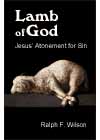
You can purchase one of Dr. Wilson's complete Bible studies in PDF, Kindle, or paperback format -- currently 48 books in the JesusWalk Bible Study Series.
- Abraham, Faith of
- Jacob, Life of
- Moses the Reluctant Leader
- David, Life of
- Songs of Ascent (Psalms 120-134)
- 28 Advent Scriptures (Messianic)
- Rebuild & Renew: Post-Exilic Books
- Christmas Incarnation (Mt, Lk)
- Sermon on the Mount (Mt 5-7)
- Luke's Gospel
- John's Gospel
- Seven Last Words of Christ
- Jesus and the Kingdom of God
- Resurrection and Easter Faith
- Early Church (Acts 1-12 )
- Apostle Paul (Acts 11-28)
Pauline Epistles
- Romans 5-8 (Christ-Powered Life)
- 1 Corinthians
- 2 Corinthians
- Philippians
- Colossians, Philemon
- 1 & 2 Thessalonians
- 1 &2 Timothy, Titus
General Epistles
- 1 & 2 Peter, Jude
- 1, 2, and 3 John
- Conquering Lamb of Revelation
- Glorious Kingdom, The
- Grace: Favor for the Undeserving
- Great Prayers of the Bible
- Holy Spirit, Disciple's Guide
- JesusWalk: Beginning the Journey
- Lamb of God
- Listening for God's Voice
- Lord's Supper: Disciple's Guide
- Names and Titles of God
- Names and Titles of Jesus
Search a pre-defined list
The Whole Bible The Old Testament The New Testament ────────────── Pentateuch Historical Books Poetical Books Wisdom Literature Prophets Major Prophets Minor Prophets ────────────── The Gospels Luke-Acts Pauline Epistles General Epistles Johannine Writings ────────────── Genesis Exodus Leviticus Numbers Deuteronomy Joshua Judges Ruth 1 Samuel 2 Samuel 1 Kings 2 Kings 1 Chronicles 2 Chronicles Ezra Nehemiah Esther Job Psalms Proverbs Ecclesiastes Song of Songs Isaiah Jeremiah Lamentations Ezekiel Daniel Hosea Joel Amos Obadiah Jonah Micah Nahum Habakkuk Zephaniah Haggai Zechariah Malachi Matthew Mark Luke John Acts Romans 1 Corinthians 2 Corinthians Galatians Ephesians Philippians Colossians 1 Thessalonians 2 Thessalonians 1 Timothy 2 Timothy Titus Philemon Hebrews James 1 Peter 2 Peter 1 John 2 John 3 John Jude Revelation
OR Select a range of biblical books
Select a Beginning Point Genesis Exodus Leviticus Numbers Deuteronomy Joshua Judges Ruth 1 Samuel 2 Samuel 1 Kings 2 Kings 1 Chronicles 2 Chronicles Ezra Nehemiah Esther Job Psalms Proverbs Ecclesiastes Song of Songs Isaiah Jeremiah Lamentations Ezekiel Daniel Hosea Joel Amos Obadiah Jonah Micah Nahum Habakkuk Zephaniah Haggai Zechariah Malachi Matthew Mark Luke John Acts Romans 1 Corinthians 2 Corinthians Galatians Ephesians Philippians Colossians 1 Thessalonians 2 Thessalonians 1 Timothy 2 Timothy Titus Philemon Hebrews James 1 Peter 2 Peter 1 John 2 John 3 John Jude Revelation
Select an Ending Point Genesis Exodus Leviticus Numbers Deuteronomy Joshua Judges Ruth 1 Samuel 2 Samuel 1 Kings 2 Kings 1 Chronicles 2 Chronicles Ezra Nehemiah Esther Job Psalms Proverbs Ecclesiastes Song of Songs Isaiah Jeremiah Lamentations Ezekiel Daniel Hosea Joel Amos Obadiah Jonah Micah Nahum Habakkuk Zephaniah Haggai Zechariah Malachi Matthew Mark Luke John Acts Romans 1 Corinthians 2 Corinthians Galatians Ephesians Philippians Colossians 1 Thessalonians 2 Thessalonians 1 Timothy 2 Timothy Titus Philemon Hebrews James 1 Peter 2 Peter 1 John 2 John 3 John Jude Revelation
OR Custom Selection:
Use semicolons to separate groups: 'Gen;Jdg;Psa-Mal' or 'Rom 3-12;Mat 1:15;Mat 5:12-22'

Click to Change
Return to Top

Paul's First Missionary Journey
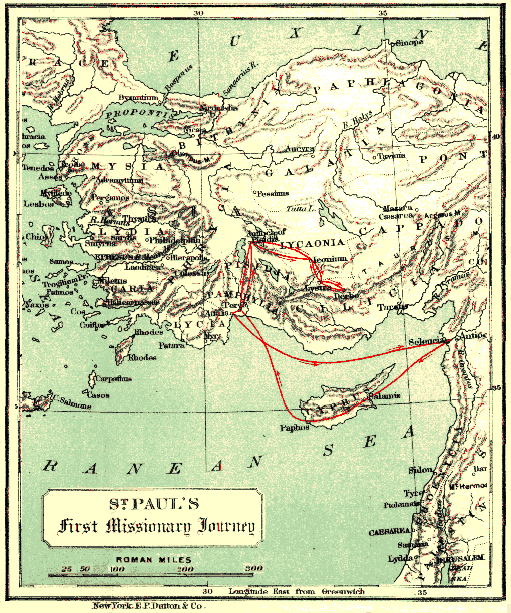
Life and Work of St. Paul (1879) by Farrar
Search Results in Other Versions
Search results by book, blb searches, search the bible.
Advanced Options
There are options set in 'Advanced Options'
Theological FAQs
Other Searches
Multi-Verse Retrieval
* 'Number Delimiters' only apply to 'Paragraph Order'
Let's Connect
Daily devotionals.
Blue Letter Bible offers several daily devotional readings in order to help you refocus on Christ and the Gospel of His peace and righteousness.
- BLB Daily Promises
- Day by Day by Grace
- Morning and Evening
- Faith's Checkbook
- Daily Bible Reading
Daily Bible Reading Plans
Recognizing the value of consistent reflection upon the Word of God in order to refocus one's mind and heart upon Christ and His Gospel of peace, we provide several reading plans designed to cover the entire Bible in a year.
One-Year Plans
- Chronological
- Old Testament and New Testament Together
Two-Year Plan
- Canonical Five Day Plan
Recently Popular Pages
- Spurgeon's Morning and Evening
- H6440 - pānîm - Strong's Hebrew Lexicon (kjv)
- An Expert Searcher by C. H. Spurgeon
- H3045 - yāḏaʿ - Strong's Hebrew Lexicon (kjv)
- David Guzik :: 1 Corintios 7 – Principios Sobre el Matrimonio y la Soltería
- David Guzik :: Hechos 2 – El Espíritu Santo Es Derramado Sobre la Iglesia
- H4672 - māṣā' - Strong's Hebrew Lexicon (kjv)
- H3548 - kōhēn - Strong's Hebrew Lexicon (kjv)
- David Guzik :: Salmo 119
Recently Popular Media
- Jehovah's Witnesses, Jesus and the Holy Trinity (Walter Martin)
- Blessings to the Barren (David Guzik)
- Luke 16-17 (1982-85 Audio) (Chuck Smith)
- Daniel 9: 70th Week [1990s] (Chuck Missler)
- The Gift of Tongues, Pt. 2 (Chuck Smith)
- 1 Kings 17-22 (1979-82 Audio) (Chuck Smith)
- Intro. - Universal Beginnings (Chuck Missler)
- Joseph, the Dreamer (Chuck Missler)
- Job 1-4 (1979-82 Audio) (Chuck Smith)
- Weddings and Wine (Tony Clark)
CONTENT DISCLAIMER:
The Blue Letter Bible ministry and the BLB Institute hold to the historical, conservative Christian faith, which includes a firm belief in the inerrancy of Scripture. Since the text and audio content provided by BLB represent a range of evangelical traditions, all of the ideas and principles conveyed in the resource materials are not necessarily affirmed, in total, by this ministry.

Blue Letter Bible
Login to your account.
Email / username or password was incorrect!
Check your email for password retrieval
Keep me logged in!
Did you forget your password?
Register a new BLB account
Complete the form below to register [?]
Error: That Email is already registered
Error: Please provide a valid Email
Error: Passwords should have at least 6 characters
Error: Passwords do not match
Error: Please provide a valid first name
Error: That username is already taken
Error: Usernames should only contain letters, numbers, dots, dashes, or underscores
← Login to Your Account
Passwords should have at least 6 characters. Usernames should only contain letters, numbers, dots, dashes, or underscores.
Thank you for registering. A verification email has been sent to the address you provided.
Did You Know BLB Is User Supported?
Your partnership makes all we do possible. Would you prayerfully consider a gift of support today?
Cookie Notice: Our website uses cookies to store user preferences. By proceeding, you consent to our cookie usage. Please see Blue Letter Bible's Privacy Policy for cookie usage details.
Old Testament
New testament.

IMAGES
VIDEO
COMMENTS
From Antioch, the two apostles and John (surnamed Mark) begin Paul's first missionary journey (Acts 13:4 - 52, 14:1 - 25). Apostle Paul and company travel to Seleucia then sail to Salamis, the principle city and seaport of the island of Cyprus. Cyprus is where Barnabas was born and raised (Acts 4:36). In Salamis, they preach the gospel in ...
48-49 A.D. Paul's First Missionary Journey is recorded in Acts 13 and 14.. The First Missionary Journey took Paul from Antioch to Cyprus then southern Asia Minor (Anatolia, modern day Turkey), and back to Antioch.. Around 46-47 AD, Paul (a.k.a. Saul), a Jewish man from the tribe of Benjamin, born in Tarsus in Cilicia, and Barnabas (a.k.a. Joses), a Jewish man from the tribe of Levi, born in ...
From Antioch Paul, Barnabas and John (surnamed Mark) begin Paul's first missionary journey (Acts 13:4 - 52, 14:1 - 25). It is the first such extensive evangelistic tour taken by Paul. The evangelism team travels to Seleucia then sails to Salamis, the principle city and seaport of the island of Cyprus.
Maps of Paul's First Missionary Journey. As a visual person, I find looking at images and maps very helpful, especially when looking at certain Biblical journeys and events. The overall map of Paul's first journey is below. This map below is a little more realistic. It doesn't show Paul's journey path, but it shows the cities and the ...
Paul's missionary journeys helped spread the gospel throughout much of the ancient world. Over the course of his ministry, the Apostle Paul traveled more than 10,000 miles and established at least 14 churches.. The Book of Acts records three separate missionary journeys that took Paul through Greece, Turkey, Syria, and numerous regions you won't find on modern-day maps.
Paul's First Missionary Journey (Acts 13:4-14:26) c. a.d. 46-47 Barnabas and Paul first visited Barnabas's home region of Cyprus before sailing to the southern region of Asia Minor. When they reached Perga in Pamphylia, John Mark left the group and returned to Jerusalem.
Paul's First Missionary Journey (. ) c. A.D. 46-47. Barnabas and Paul first visited Barnabas's home region of Cyprus before sailing to the southern region of Asia Minor. When they reached Perga in Pamphylia, John Mark left the group and returned to Jerusalem. Making their way to Antioch (in Pisidia), Iconium, Lystra, and Derbe, Paul and ...
51-53 A.D. Paul's Second Missionary Journey is recorded in Acts 16, 17 and 18. Paul and Barnabas separate over a disagreement on whether or not to take John Mark on this second evangelistic voyage, because he had left them during the first journey. Eventually, Barnabas decided to take John Mark to Cyprus with him, while Paul took Silas to ...
Map of Paul's first mission journey. From about 46 AD to 48 AD (more than 1900 years ago), Paul the evangelist undertook his first mission journey. He traveled from Syrian Antioch to Derbe, and back again. This journey is described in the Bible's book of Acts, chapters 13 and 14.
Maps of the Missionary Journey's of Paul the Apostle in the First Century A.D. The missionary voyages of the apostle Paul from Jerusalem to Rome. This map also shows much of the Roman Empire in the time of Paul and his journeys. The order which prevailed in this extensive empire, the good military roads, and the use of Koine Greek as the ...
Explore the interactive map of Paul's Missionary Journeys, where you can see ancient and modern places overlaid with the routes of his travels. Learn more about the historical and geographical context of his ministry and zoom in to discover the roads and cities he visited.
This map was created by a user. ... - Apostle Paul's first journey - Apostle Paul's second journey - Apostle Paul's third journey - Apostle Paul's journey to Rome In order to 'fly over' the ...
Bible Maps. Paul's First Missionary Journey. High resolution laser quality maps. 600X600 DPI (200 KB each) Return to www.bible.ca/maps/ Click on image to see ultra ...
16 Standing up, Paul motioned with his hand and said: "Fellow Israelites and you Gentiles who worship God, listen to me! Acts 14, In Iconium. 1 At Iconium Paul and Barnabas went as usual into the Jewish synagogue. There they spoke so effectively that a great number of Jews and Greeks believed.
Here is a map of Paul's first missionary journey to help you follow along in the account of the events. Paul's first missionary journey is recorded in Acts 13 and 14. As persecution in Jerusalem increased, Christian believers fled and dispersed throughout the region. Thus Antioch in Syria became a quickly growing church.
Map locations #4, #5, #6Spring to Summer 36 A.D. Paul travels to Jerusalem and stays fifteen days. Although he tries to get to know other converted people in Jerusalem, the brethren are suspicious of him and stay away (Acts 9:26). Barnabas, a disciple known for encouraging others, takes Paul to the apostles and personally vouches for his ...
Apostle Paul - Maps of His Journeys. by Dr. Ralph F. Wilson. Free E-mail Bible Study King Solomon: Wisdom, Wealth, Weakness. The Mediterranean World in Paul's Day (small) 2012. Tarsus of Cilicia, Paul's Home 2019 ( small) Paul's Early Travels (Eastern Mediterranean, 33-46 AD) 2019 ( small) Arabia in the Time of St. Paul 2019 ( small)
Page 3 PAUL'S FIRST MISSIONARY JOURNEY MAP OF PAUL'S FIRST MISSIONARY JOURNEY 1. Paul, Barnabas and Mark leave Syrian Antioch and arrive in Cyprus 2. From Cyprus they sail to Perga. Mark leaves the group. 3. Next stop is Pisidian Antioch 4. Driven out of Antioch they continue on to Iconium. 5. Once again the crowds drive them out and they ...
Paul's First Missionary Journey approx. 48 A.D. Found in Acts 13:4-52; Acts 14:1-28. This image is a map of the Life and Work of St. Paul (1879) by Farrar.
1st Class £17 - £20. 1st class compartment. Dariusz Sieczkowski. ... St Paul's Cathedral, London, is an Anglican cathedral, the seat of the Bishop of London and the mother church of the Diocese of London. ... all the transport options for your trip from Moscow to London right here. Rome2Rio displays up to date schedules, route maps, journey ...
Tickets cost RUB 200 - RUB 230 and the journey takes 43 min. Train operators. Central PPK Phone 8 (800) 775-00-00 Website central-ppk.ru Train from Moscow Kursky Station to Fryazevo ... route maps, journey times and estimated fares from relevant transport operators, ensuring you can make an informed decision about which option will suit you ...
Rome2Rio displays up to date schedules, route maps, journey times and estimated fares from relevant transport operators, ensuring you can make an informed decision about which option will suit you best. Rome2Rio also offers online bookings for selected operators, making reservations easy and straightforward. ...
Launch map view. Distance: 63 km; Duration: 39 min; ... Tickets cost RUB 200 - RUB 240 and the journey takes 29 min. Train operators. Central PPK Phone 8 (800) 775-00-00 Website central-ppk.ru Train from Fryazevo to Ploschad Tryokh Vokzalov Ave. Duration 29 min Frequency ...